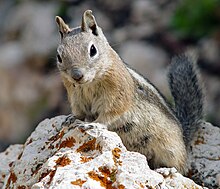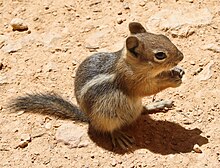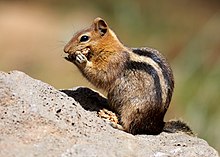
Chipmunks are small, striped rodents of Sciuridae, the squirrel family; specifically, they are ground squirrels (Marmotini). Chipmunks are found in North America, with the exception of the Siberian chipmunk which is found primarily in Asia.

The western gray squirrel is a tree squirrel found along the western coast of the United States and Mexico. In some places, this species has also been known as the silver-gray squirrel, the California gray squirrel, the Oregon gray squirrel, the Columbian gray squirrel and the banner-tail. There are three geographical subspecies: Sciurus griseus griseus ; S. g. nigripes ; and S. g. anthonyi.
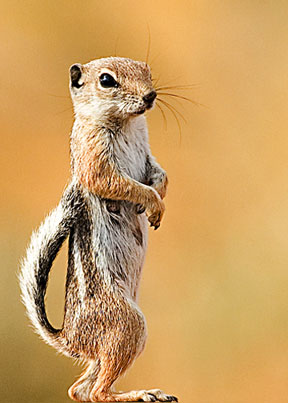
Antelope squirrels or antelope ground squirrels of the genus Ammospermophilus are sciurids found in the desert and dry scrub areas of the southwestern United States and northern Mexico. They are a type of ground squirrel and are able to resist hyperthermia and can survive body temperatures over 40 °C (104 °F).

The northern Idaho ground squirrel is a species of the largest genus of ground squirrels. This species and the Southern Idaho ground squirrel were previously considered conspecific, together called the Idaho ground squirrel.

The hoary marmot is a species of marmot that inhabits the mountains of northwest North America. Hoary marmots live near the tree line on slopes with grasses and forbs to eat and rocky areas for cover.

The eastern chipmunk is a chipmunk species found in eastern North America. It is the only living member of the genus Tamias.
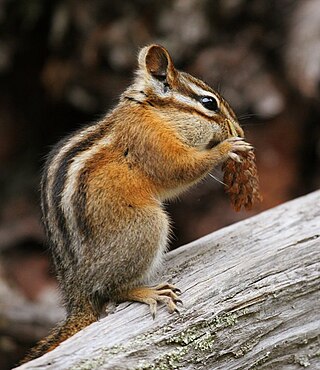
The least chipmunk is the smallest species of chipmunk and the most widespread in North America.

The alpine marmot is a large ground-dwelling squirrel, from the genus of marmots. It is found in high numbers in mountainous areas of central and southern Europe, at heights between 800 and 3,200 m (2,600–10,500 ft) in the Alps, Carpathians, Tatras and Northern Apennines. In 1948 they were reintroduced with success in the Pyrenees, where the alpine marmot had disappeared at end of the Pleistocene epoch.

The short-tailed field vole, short-tailed vole, or simply field vole is a grey-brown vole, around 10 cm in length, with a short tail. It is one of the most common mammals in Europe, with a range extending from the Atlantic coast to Lake Baikal. These voles are found in moist grassy habitats, such as woodland, marsh or on river banks. Although they make shallow burrows, they usually build nests above ground. They are an important food source for owls and some other predators and their population size tends to peak and trough cyclically. Field voles breed prolifically, mainly in summer, but often all year round, even under snow. Females produce up to seven litters a year, each averaging from four to six young which are weaned after about fourteen days. The short-tailed field vole is both widespread and common and is listed as being of "Least Concern" by the IUCN.

The European ground squirrel, also known as the European souslik, is a species from the squirrel family, Sciuridae. It is among the few European species in the genus Spermophilus. Like all squirrels, it is a member of the rodent order. It is to be found in eastern and central Europe from southern Ukraine, to Asia Minor, Austria, the Czech Republic, Slovakia, Serbia, Greece, Romania, Bulgaria, North Macedonia and north as far as Poland but the range is divided in two parts by the Carpathian Mountains.

Abert's squirrel or the tassel-eared squirrel is a tree squirrel in the genus Sciurus native to the southern Rocky Mountains from the United States to the northern Sierra Madre Occidental of Mexico, with concentrations found in Arizona, New Mexico, and southwestern Colorado. It is closely associated with, and largely confined to, mature ponderosa pine forests. It is named in honor of the American naturalist John James Abert; nine subspecies are recognised. It is recognizable by its tufted ears, gray color, pale underparts and rufous patch on the lower back. The squirrel feeds on the seeds and cones of the Mexican pinyon and the ponderosa pine when they are available, but will also take fungi, buds, bark, and carrion. Breeding normally occurs in summer, with a spherical nest being built high in the canopy.

The western harvest mouse is a small neotomine mouse native to most of the western United States. Many authorities consider the endangered salt marsh harvest mouse to be a subspecies, but the two are now usually treated separately.

Belding's ground squirrel, also called pot gut, sage rat or picket-pin, is a squirrel that lives on mountains in the western United States. In California, it often is found at 6,500 to 11,800 feet (2,000–3,600 m) in meadows between Lake Tahoe and Kings Canyon. This species is not of conservation concern, and its range includes some protected areas.
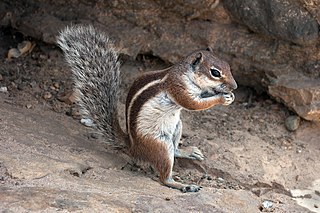
The Barbary ground squirrel is a species of rodent in the family Sciuridae. It is monotypic within the genus Atlantoxerus. It is endemic to the Atlas mountains in Morocco and some parts in Algeria, and has been introduced into the Canary Islands. Its natural habitats are subtropical or tropical dry shrubland, temperate grassland and rocky areas where it lives colonially in burrows. It was first described by Carl Linnaeus in his landmark 1758 10th edition of Systema Naturae.

The Columbian ground squirrel is a species of rodent common in certain regions of Canada and the northwestern United States. It is the second largest member of the genus Urocitellus, which is part of the tribe Marmotini, along with marmots, chipmunks, prairie dogs, and other holarctic ground squirrels. They are stout, with short dense fur, which is characteristically tawny across the bridge of the nose. Social encounters sometimes are initiated with kissing behavior and the most common activity above ground is standing at attention. Residing in mountainous terrain and high plains in northern latitudes, they hibernate for 8 to 9 months of the year in burrows, which may be used for many years. They are emaciated when emerging in the spring. The Columbian ground squirrel came to the attention of the scientific community through writings produced by Lewis and Clark, while 21st century molecular genetics has more finely illuminated its ties with other close relatives.

The little ground squirrel or little souslik, is a species of rodent in the family Sciuridae. It is found from Eastern Europe to Central Asia.

The Cascade golden-mantled ground squirrel is a species of rodent in the family Sciuridae, in the order Rodentia. It is the largest species of the three within the genus Callospermophilus. It is found in the Cascade Mountains in the province of British Columbia, Canada and the state of Washington, United States.

The rock squirrel is a species of rodent in the family Sciuridae. It is native to Mexico and the Southwestern United States, including southern Nevada, Utah, Colorado, Arizona, New Mexico, West Texas, and the panhandle of Oklahoma.

Palmer's chipmunk is a species of rodent in the family Sciuridae, endemic to Nevada. Its natural habitat is temperate forests. It is threatened by habitat loss. It is named after Theodore Sherman Palmer, an American botanist and zoologist.

The Colorado chipmunk is a species of chipmunk in the squirrel family Sciuridae. It is endemic to Colorado, Utah, Arizona and New Mexico in the United States.
